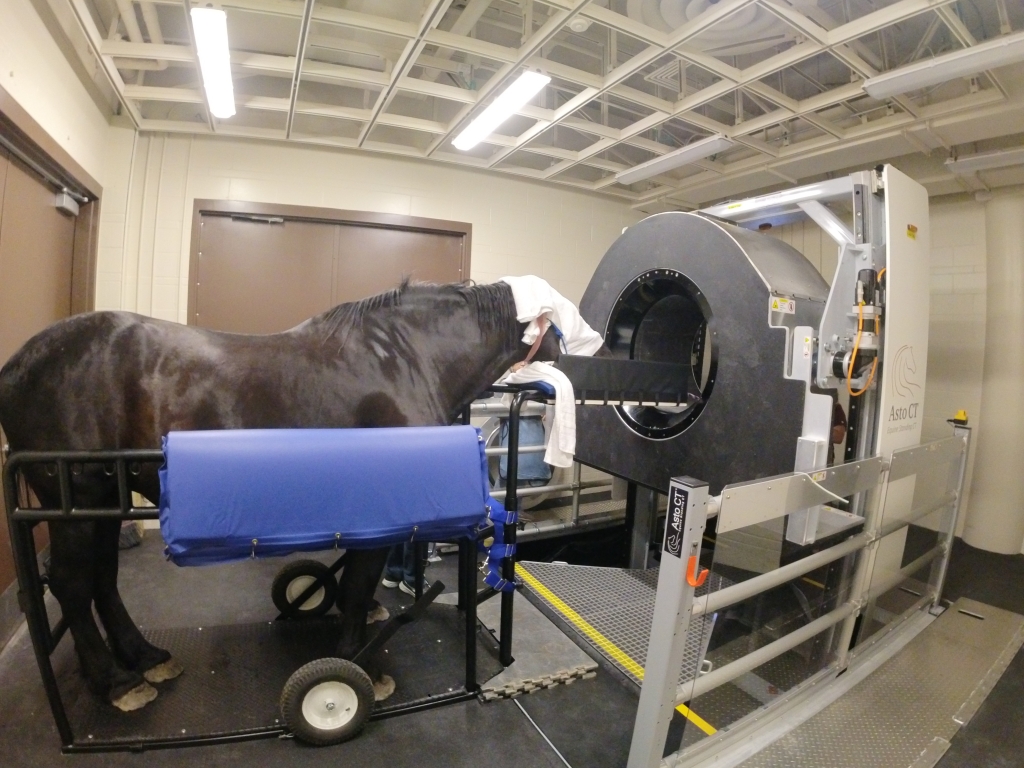
New Equine CT Scanner Installed At Mizzou
In the heart of the Midwest stands the University of Missouri Veterinary Health Center (Columbia, MO), known for its state-of-the-art facilities and high levels of care. They have increased their capabilities further with the installation of an equine standing CT (Computed Tomography) scanner.
MU Equine Clinician Dr. Kevin Keegan states, “This is a fan-beam CT that has high image quality with reduced radiation exposure and allows for true standing imaging. Previously we were scanning all our CT cases under general anesthesia. Now we have the ability to scan front and hind limb pairs and the head and neck with only light sedation. This will fast-track the treatment and prognosis in many cases. We see this technology becoming widely adopted among horse owners because of the reduced cost and quick scans.”
Scan of front left limb showing severe osteoarthritis.
The Equina was installed in two and a half days and was immediately put to test. The team at MU successfully scanned a 16-year-old quarter horse gelding. During the procedure, the horse remained conscious under light sedation[BC1] , thus decreasing risks associated with general anesthesia. They diagnosed him with severe osteoarthritis of the pastern joint (see scan of front left limb). The MU team was also able to scan the head and both front and hind limbs of a 2,000-pound Percheron draft mare, proving the CT scanner’s diverse capabilities.
Image of 2,000 lb. Percheron draft mare receiving a head scan.
During system training, University of Missouri President Mun Y Choi visited the new Equine CT scanner at the MU VHC Equine Hospital.
The MU Veterinary Equine Hospital services a wide variety of horses including recreational, sport, and western horses. The installation of the standing CT will greatly benefit horses and owners by offering clients peace of mind and a better experience for their equine athlete.
MU Teaching Professor Dr. Joanne Kramer, reflects on the technology’s importance “Having this technology on site at Mizzou allows us to diagnose pathology in the head and neck and disease in the limbs. The standing CT reduces the risks involved in the procedure by removing the need for general anesthesia. We’re planning to use the CT on a wide variety of cases.”
Asto CT CEO, David Ergun, comments “Asto CT is thrilled to partner with the MU VHC Equine Hospital and its vibrant equine community in Missouri. The CT technology will be the first of its kind in the state and will aid in diagnosing a wide range of pathology in equine patients. The Equina is being installed in the same town where Equinosis Q was founded. We believe there is a strong synergy between the two companies where lameness diagnosis and CT technology go hand in hand.”
More information can be found at vhc.missouri.edu/equine-hospital/. For more information on the Asto CT Equina visit www.astoct.com/equina
[BC1]I would suggest explaining what you mean by "light sedation" compared to "general anesthesia." Depending on the audience, this could be perceived as a contradiction in claims. (You said the horse didn't need to be sedated, but in the first case, you had to lightly sedate. -- I believe I understand the difference, but an extra phrase or sentence to clarify might be helpful if this is going to a non-medical audience.)
More from Companion Consultancy
- CoVet partners with Merlin to boost client communication and reduce admin workload
- Dignipets releases new pet Quality of Life monitoring app in time for London Vet Show
- Dr Kelly Foden to offer end-of-life care in Taunton and South Somerset with Dignipets
- KRKA UK honours excellence in its Veterinary Reception Awards 2025
- KRKA UK and Professor Stuart Carmichael lead LVS session on rethinking canine osteoarthritis

 2 years ago
2 years ago  1441 views
1441 views
